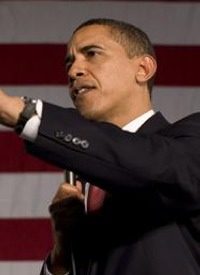
“The ‘pay as you go’ rule is very simple,” Obama told reporters on June 9. “Congress can only spend a dollar if it saves a dollar elsewhere.” His budget director, Peter Orszag, put it similarly the same day: “Pay as you go embodies the common-sense principle that you shouldn’t dig the hole any deeper.” But there’s a scam inside of Obama’s newfound love of fiscal responsibility: Obama decided he didn’t want to dig the nation any deeper into the deficit hole only after the proposals his administration was able to get Congress to enact had jacked up the deficit another $1 trillion. Even the leftist New York Times took note of the hypocrisy of the timing of the announcement:
But the announcement — just one day after Mr. Obama lauded the billions of dollars his administration was spending to save or create what the White House estimated as 600,000 new jobs this summer — quickly turned into Round 2 of an escalating war between the White House and Republicans over Mr. Obama’s claims of fiscal responsibility.
In other words, Obama’s announcement in favor of PayGo came after nearly six months of spending increases that inflated the deficit by an additional $1 trillion to a total of more than $2 trillion (overly optimistic official estimates put the figure at $1.8 trillion at this point) for the current fiscal year. Obama decided not to dig the hole deeper only after he turned the hole into an abyss. Obama’s declaration is not unlike the drunk driver who, after accelerating to 80 miles per hour and an instant before crashing into a telephone pole, takes his foot off the gas with the self-righteous declaration: “I’m going to be responsible by not moving toward disaster at a faster rate than I was otherwise going.”
Obama’s June 9 statement was replete with well-worn slogans, including the false statement that “in the next four years the deficit will be cut in half.” Such a statement relies upon economic data that is already months out of date. Obama’s budget assumes the U.S. Gross Domestic Product (GDP) would shrink by only 1.2 percent during the current fiscal year (which began October 2008). But it’s already shrunk by more than three percent, and it appears that the shrinkage will continue through the end of the year.
Obama also recycled tired, old Bush-era talking points, such as: “Over the next decade, non-defense discretionary spending will reach its lowest level as a share of our national income since we began keeping records in 1962.” This is the same propaganda that President Bush was peddling as he and his compliant Congresses (regardless of which party was in charge) racked up bigger and bigger deficits. The one difference is that Bush’s propaganda was at least based closer to hard numbers than Obama’s relativist statement. Obama noted that non-defense discretionary spending was cut only with regard to "national income," meaning the Gross Domestic Product (GDP). And the GDP is one thing Obama assumes is going to grow like crazy throughout his administration; his budget assumes nearly four percent annual growth in the GDP. “My Budget proposes to keep non-security discretionary spending below inflation for the next five years,” President Bush proudly announced in the introduction to his Fiscal 2008 budget. So much for the myth that controlling non-defense discretionary spending is the key to controlling the deficit.
Non-defense discretionary spending is not a realistic metric for fiscal responsibility. It already comprises less than one-sixth of the $3.9 trillion in total federal spending, so further cuts in that area — while helpful — won’t solve the problem. In fact, cutting all non-defense discretionary spending from the budget still wouldn’t balance the budget. The $609 billion in non-defense discretionary spending for the current fiscal year is only a little more than a quarter of the deficit this year.
Obama said that he favored PayGo because “paying for what you spend is basic common sense. Perhaps that’s why, here in Washington, it’s been so elusive.” Since the White House website didn’t put the video for the statement online, it’s impossible to tell from the text if he knew he was talking about himself with that statement.
Meanwhile, the Republicans are getting in their partisan digs while they can. “President Obama and Congressional Democrats telling Americans they are committed to budget discipline is like Charles Ponzi telling people to trust him with their money,” the Republican National Committee said in a statement to reporters. Of course, the Republican National Committee is correct in its criticism of the Democrats. This is not to say that the Republican Party leadership is measurably better. When the House Republicans offered their own alternative budget proposal, it called for $500 billion-plus annual deficits into the indefinite future. Barack Obama’s budget proposal is $600 billion-plus deficits forever, and both Obama and the GOP alternative budget rely upon economic data that is already too optimistic for revenue and demands on existing spending commitments to be considered realistic.
To be fair, Obama told a truth — a partial truth, anyway — in his announcement in favor of PayGo, when he explained that “there are few who aren’t distressed by deficits. It’s a concern that crosses party lines, geographic boundaries, and ideological divides.” Lack of concern over deficits certainly is a concern that infests the White House as well as both the Republican and Democratic leadership in Congress, though it’s debatable that that lack of concern crosses “ideological divides.” The Keynesian Democrats who run the White House have demonstrated an utter lack of concern for deficits, just as the Keynesians running the Republican Party leadership have demonstrated no concern.
Two small groups of Keynsians agreeing that deficits don’t matter hardly qualifies as an ideological divide. But, except for Congressman Ron Paul (R-Texas), that pretty much sums up the ideological spectrum running Washington these days.


